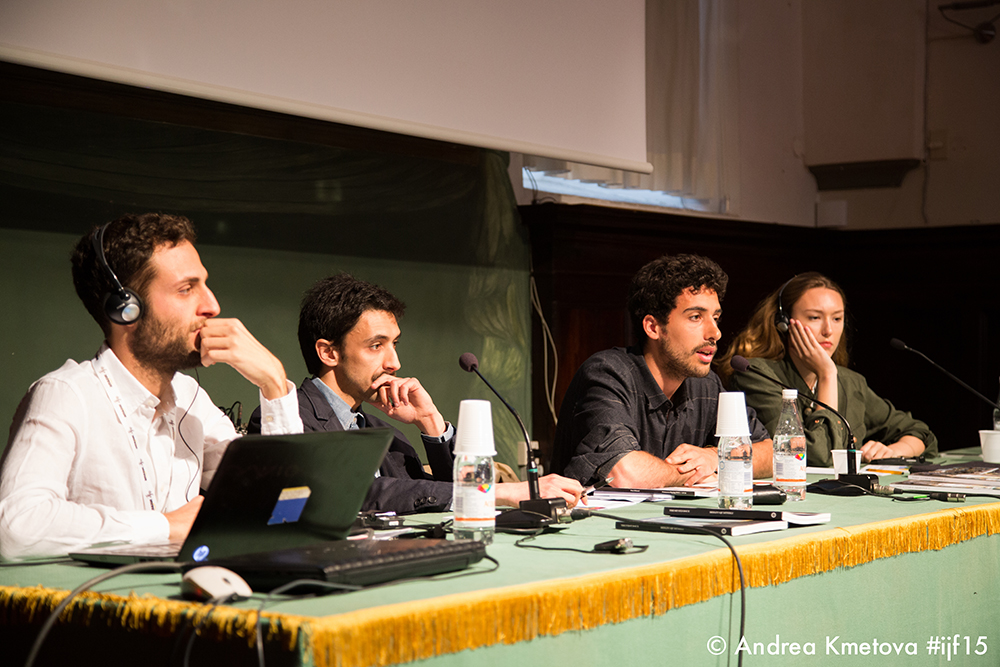
Print is not dead. Far from it, in fact, according to a panel of independent magazine founders gathered at the International Journalism Festival on Thursday.
Throughout the discussion, Ricarda Messner, founder of Flaneur magazine, Cesare Alemanni, co-founder and editor of Berlin Quarterly and Ibrahim Nehme, founder and editor of The Outpost, explored the flourishing small independent magazine scene that has sprung up even in the midst of the crisis facing traditional print media.
“What these different publications have in common — they are all very different, some are larger, some are smaller — is they’re all trying to reinvent an old model,” Alberto Mucci, The Outpost’s assistant editor and a regular contributor to Studio, said to kick off the event.
There’s clearly a big market for independent print publications, the editors agreed, but the focus now needs to turn to making the format sustainable beyond the initial boom of new print magazines. The panellists tossed out a number of ideas to keep print alive, from creating a publishing house for independent magazines to rethinking advertising to hosting events targeted to readers.
Print isn’t dead — but the future still needs to be secured, the editors said.
“At this point, it’s a question of how we can move forward with this and create a sustainable publishing environment,” Nehme said. “There’s an obvious need for this kind of thing.”
Nehme said The Outpost, which started three years ago in Beirut, functions as an “activist magazine” that “aims to become a catalyst for social change in the Middle East.” The sense that some traditional media organisations were out to “insult the intelligence of readers” with their editorial content spurred The Outpost’s creation, he said.
“Essentially there was a need for us, makers of printed titles, to actually reclaim the news, reclaim the shelves in a way, and create publications that respect readers,” he told the crowd.
For Messner, Flaneur had a deeply personal beginning: “The magazine was actually my therapy.” Messner said she found herself “disoriented” with her degree and started walking the streets of her hometown, Berlin. From that, in early 2013, Flaneur emerged as a print magazine in which each issue centers solely on one street in a different city.
“We want to push the boundaries of print,” Flaneur said, noting that each issue is designed completely differently and features a section dubbed “Unprintables” where they team up with musicians, filmmakers or others to produce content that is not typically associated with print.
Messner said her magazine depends on the classic advertising revenue model, but with a twist. The ad section can only be found at the back of each issue, and it’s “very exclusively curated to brands” that fit the Flaneur philosophy, she said.
For the Berlin Quarterly, a sponsor financed the first four issues, Alemanni said, and now the magazine is working on finding advertisers who also match up with their product.
“It’s not easy, of course, to survive as a printed press today, but it’s not impossible,” he said, noting the English-language magazine is currently selling best in London and New York.
With The Outpost, meanwhile, the magazine initially tried to secure advertising, but turned to crowdfunding when it became clear that model wouldn’t work for their product. The publication is now investigating more sustainable options by looking into hosting events and enlisting the help of their readers.
“We are not part of this corporate system and we will never be part of it, so in order to ensure our sustainability… we need to come up with new ideas,” Nehme said.
That also involves The Outpost’s online presence, Nehme added. It’s not about rehashing the content of the print edition and putting it online — for The Outpost, the Internet offers a chance to create a network for its activist readership, not a hub for content, he said.
“Primarily our digital platform is going to be a network for activists to connect with each other,” he said.
As for the future, Messner offered up one way to create a sustainable environment for the independent printed press that puts a spin on the traditional publishing world: “A publishing house for independent magazines is very necessary,” she said.
Calling the world of small print publishers “a family” that stays in touch and follows fellow magazines, she stressed the need for publications to take that sensibility further. It’s critical, Messner told attendees, for independent magazines to team up and work together to create a kind of independent Condé Nast-style print media company.
“There is a lot of potential,” she said. “We should create synergies — for production, for advertising, for distribution.”